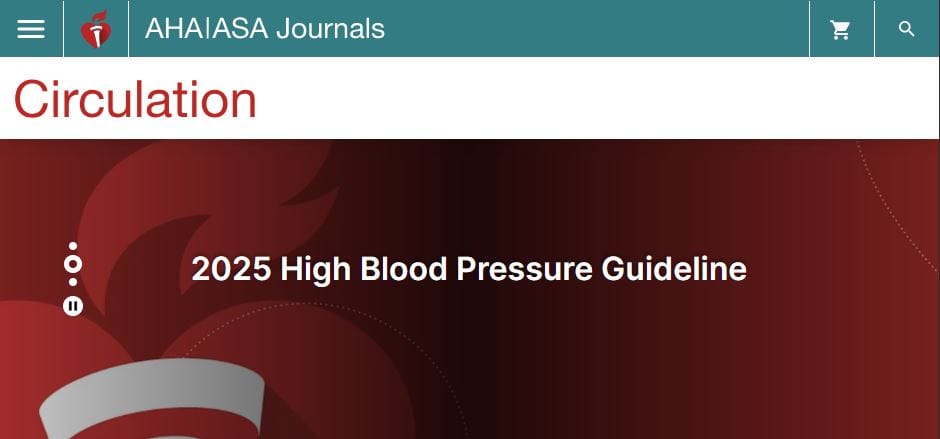Updates in the 2025 ACC/AHA Hypertension Guidelines
The 2025 ACC/AHA hypertension guidelines emphasize earlier detection, lifestyle changes, new PREVENT™ risk tool, and team-based care.

Author: Ricky Jobe, PharmD Candidate 2028
Editor: Kristen Lindauer, PharmD, BCPS, AAHIVP
On August 14th, the American College of Cardiology (ACC) and American Heart Association (AHA) published their latest guidelines on the prevention, diagnosis, and treatment of hypertension. This marks the first update to this guideline since 2017. The 2017 guidelines represented a shift towards more aggressive diagnosis and treatment of hypertension, a condition estimated to affect 48.1% of adults in the United States. The new 2025 ACC/AHA guidelines continue this trend of promoting earlier detection and treatment of hypertension, which is the #1 modifiable risk factor for cardiovascular disease. Consistent with prior recommendations, the guidelines reaffirm a blood pressure goal of <130/80 mmHg for most adults. While there are many similarities to the 2017 guidelines, there are some important changes to be aware of as a pharmacist or pharmacy student. Here is a review of those changes.
Change from 10-year ASCVD risk to PREVENT™ calculator
The 2025 guidelines introduce the PREVENT™ calculator for estimating the risk of developing cardiovascular disease (CVD). This new calculator was developed by the AHA and estimates both 10-year and 30-year risk in individuals ages 30-79. The previous calculator used in the 2017 guidelines only measured for 10-year risk of atherosclerotic cardiovascular disease (ASCVD). The PREVENT™ calculator additionally measures heart failure risk, reflecting its significant contribution to long-term cardiovascular outcomes and allowing for earlier intervention. The PREVENT™ calculator goes beyond traditional risk factors for CVD and incorporates kidney health, metabolic health, and factors in social determinants differently. Previously, race was used as an input. Now the patient’s zip code is used. The goal of this new calculator is to provide a more individualized assessment of each patient and to detect the risk of CVD sooner, allowing for action to be taken as soon as possible.

Emphasis on Lifestyle Changes for Prevention
The 2025 guidelines place more weight on the importance of lifestyle changes for lowering blood pressure. The DASH-style diet is still recommended with a target daily sodium intake of less than 1,500 mg. Additionally, potassium-based salt substitutes are now encouraged. The new guidelines recommend complete abstinence from alcohol, a major shift from moderate alcohol intake being considered the lowest risk category for decades. While the 2017 guidelines recommended individuals to aim for a healthy BMI, the new guidelines take a stronger stance, recommending a 5% or greater reduction in weight in overweight individuals, with GLP-1 agonists and bariatric surgery being considered in severe obesity. Previously being a side note, stress management now becomes a core strategy with meditation, yoga, and breathing exercises being explicitly recommended. Placing greater emphasis on lifestyle changes aims to prevent hypertension before it becomes necessary to begin pharmacological treatment.
Faster and More Efficient Drug Therapy
Utilizing the new PREVENT™ calculator, it is now recommended to start with pharmacological agents in addition to lifestyle changes to treat patients with Stage 1 Hypertension who also have a 10-year calculated risk of >7.5%. This is a lower threshold than the old guidelines of 10% 10-year ASCVD risk. Thiazide diuretics, dihydropyridine calcium channel blockers, angiotensin converting enzyme inhibitors, and angiotensin receptor blockers remain first-line therapy options. The 2017 guidelines did not specify the dihydropyridine class of calcium channel blockers, so this is a crucial clarification. For Stage 2 hypertension, single combination pill therapies are now emphasized to improve medication adherence by simplifying drug therapy regimens for patients. This marks a shift toward earlier initiation of pharmacological treatment and more efficient treatment by using combination pill therapy.
Changes in Resistant Hypertension Treatment
It is now recommended that all patients with resistant hypertension (defined as patients on >3 antihypertensive therapies who are still not at blood pressure goal) undergo screening for hyperaldosteronism. It is estimated that up to one-third of patients with resistant hypertension also have hyperaldosteronism and could potentially benefit from targeted treatments to disrupt the aldosterone pathway. A second major guideline change for treatment of resistant hypertension is the addition of renal denervation as a treatment option. However, this treatment is not first-line; it states that renal denervation candidates should be assessed by an expert team, informed of risks, and should decide on the procedure collaboratively with their physician.
Focus on the Team-Based Care Approach
The 2025 guidelines stress multidisciplinary team-based care to improve patient outcomes. This multidisciplinary team includes physicians, pharmacists, nurse practitioners, nurses, physician assistants/associates, dieticians, community health workers, and other health care professionals. Going further, it encourages clinicians to collaborate with community leaders, organizations, and health departments to improve public awareness and reduce barriers to care.
What This Means for You
In conclusion, the 2025 ACC/AHA Hypertension Guidelines represent a shift toward individualized patient care, an interdisciplinary team-based approach to treatment, a strong emphasis on lifestyle changes and prevention, and earlier intervention to treat hypertension sooner and more efficiently. In addition to being the medication experts on the multidisciplinary health care team, pharmacists are, in many cases, the most accessible members of the health care team. This makes pharmacists and pharmacy students uniquely positioned to lead the charge in early detection, patient education, and medication optimization.
About the Author

References
- CDC. (2021, March 22). Hypertension Prevalence in the U.S. | Million Hearts®. Centers for Disease Control and Prevention. https://millionhearts.hhs.gov/data-reports/hypertension-prevalence.html
- Francis, M. (2023, November 10). Leading cardiologists reveal new heart disease risk calculator. American Heart Association. https://newsroom.heart.org/news/leading-cardiologists-reveal-new-heart-disease-risk-calculator
- Harrison, D. G., & Touyz, R. M. (2025). Hypertension Editors’ View of the 2025 Guideline for the Prevention, Detection, Evaluation, and Management of High Blood Pressure in Adults. Hypertension. https://doi.org/10.1161/hypertensionaha.125.25467
- Jones, D. W., Ferdinand, K. C., Taler, S. J., Johnson, H. M., Daichi Shimbo, Abdalla, M., Altieri, M. M., Bansal, N., Bello, N. A., Bress, A. P., Carter, J., Cohen, J. B., Collins, K. J., Commodore-Mensah, Y., Davis, L. L., Egan, B., Khan, S. S., Lloyd-Jones, D. M., Melnyk, B. M., & Mistry, E. A. (2025). 2025 AHA/ACC/AANP/AAPA/ABC/ACCP/ACPM/AGS/AMA/ASPC/NMA/PCNA/SGIM Guideline for the Prevention, Detection, Evaluation and Management of High Blood Pressure in Adults: A Report of the American College of Cardiology/American Heart Association Joint Committee on Clinical Practice Guidelines. PubMed. https://doi.org/10.1161/cir.0000000000001356

